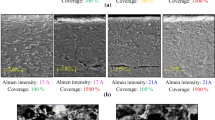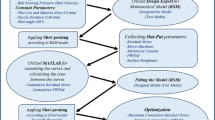Abstract
The attempt of this paper is to present an effective approach for the optimization of the shot peening process of welded AISI 304 austenitic stainless steel with multi performance characteristics using Grey relational analysis (GRA) based on Taguchi orthogonal array. Twenty-seven experimental runs are performed to determine best process parameters level. An analysis of variance (ANOVA) is carried out to identify significant peening parameters. The response tables are obtained for analyzing the optimal levels of shot peening parameters and major factors that affect the quality function. The multiple performance characteristics including tensile strength, surface hardness and surface roughness are the quality functions considered for the optimization. Further mathematical models are developed using regression analysis for the tensile strength, surface hardness and surface roughness. It will be very helpful to the engineers in deciding the levels of the shot peening parameters for desired performance characteristics.
Similar content being viewed by others
References
M. Ohsawa and T. Yonemura, Improvement of hardened surface by shot peening, ICSP 4, Japan (1990) 147–158.
M. L. Aggarwal, R. A. Khan and V. P. Aggarwal, Influence of shot peening intensity of fatigue design reliability of 65Si7 spring steel, Indian Journal of Engg. & Material Science, 12(6) (2005) 515–520.
L. Singh, R. A. Khan and M. L. Aggarwal, Influence of residual stress on fatigue design of AISI 304 stainless steel, The Journal of Engineering Research, 8(1) (2011) 44–52.
V. S. Nandkarni and M. C. Sharma, Behaviour of shot peened electron beam welded stainless steel plate samples under combined reverse torsional and bending cyclic stress, 7 th international conference on shot peening, Poland, 161–166.
X. Ling, H. Ni and M. A. Gang, Investigation of the influence of shot peening on stress corrosion cracking of stainless steel welded joints, Material Science Forum, 575–78 (2008) 672–677.
L. Singh, R. A. Khan and M. L. Aggarwal, Enhancement of surface characteristics and mechanical properties of welded AISI 304 stainless steel, National conference on advanced manufacturing techniques, S.M.V.D. University, India (2009) 62–68.
L. Wagner and C. Mueller, Effect of shot peening on fatigue behavior in Al-alloys, Mater Mfg. Process, 7(3) (1992) 423–440.
T. Dorr, M. Hilpert, P. Beckmerhagan and A. Kiefer, L. Wagner, Influence of shot peening on fatigue performance of high-strength aluminum-and magnesium alloys, Proceedings of the ICSP-7 conference, Warsaw, Poland (1999).
M. Obata, A. Sudo, Effect of shot peening on residual stress and stress corrosion cracking for cold worked austenitic stainless steel, Proceedings of the ICSP-5 conference, Oxford, UK (1993).
K. B. Prakash, B. M. Sunil and Y. S. Chandrakant, Shot peening: state of-the-art. Proceedings of the ICAMMP conference, IIT Kharagpur (2006) 296–303.
J. Champaigne, Controlled shot peening, The Shot Peener, Mishawaka, USA, 2nd edn. (1989).
P. Aravindan, S. R. Deavadasan, B. V. Dharmendra and V. Selladurai, Continuous Quality Improvement through Taguchi Online Quality Control Methods, International Journal of Operations & Production Management, 15(7) (1995) 60–77.
P. J. Ross, Taguchi Techniques for Quality Engineering, McGraw-Hill, New York (1988).
R. K. Roy, Design of Experiments using the Taguchi approach: 16 steps to Product and Process, Improvement, Wiley-Interscience, New York (2001) 179–186.
S. M. Phadke, Quality Engineering Using Robust Design, Englewood Cliffs, NJ: Prentice Hall (1989).
J. L. Deng, Basic methods of Grey System, Press of Huazhong University of Science and Technology, Wuhan, China, 1st edn. (1987) 33–48.
J. L. Deng, 1989, Introduction to grey system theory, J. Grey Syst., 1 (1989) 1–24.
R. Jeyapaul, P. Shahabudeen and K. Krishnaiah, Quality management research by considering multi-response problems in the Taguchi method-a review, Int. J. Adv. Mfg. Tech., 26 (2005) 1331–1337.
F. S. Chen, T. C. Chang and H. H. Liao, The application of grey relation analysis on teacher appraisal, IE Times New Roman EE International conference on Systems Man and Cybernetics, 5 (2000) 6–10.
S. Bin, Y. Ping, L. Yunbai and W. Xishan, Study on the fault diagnosis of transformer based on the grey relation analysis, International conference power system technology, China, 4 (2002) 2231–2234.
J. L. Lin and C. L. Lin, The use of the orthogonal array with grey relational analysis to optimize the electrical discharge machining process with multiple performance characteristics, Int. J. Mach. Tool & Mfg., 42(2) (2002) 237–244.
T. C. Chang and S. J. Lin, Grey relation analysis of carbon dioxide emissions from industrial production and energy uses in Taiwan, Journal of Environmental Management, 56(4) (1999) 247–257.
Author information
Authors and Affiliations
Corresponding author
Additional information
Recommended by Associate Editor Jin Weon Kim
Lakhwinder Singh presently works in YMCA University of Science & Technology, Faridabad, Haryana (India) as an Associate Professor in Department of Mechanical Engineering. His M.E. is from Punjab Engineering College, Chandigarh (India) in the field of Rotodynamic Machines. He submitted Ph.D work in Jamia Millia Islamia, New Delhi (India) in the field of shot peening. He has published 15 papers in international and national journals/conferences.
R. A. Khan is presently a Professor in the Department of Mechanical Engineering in Jamia Millia Islamia, New Delhi (India). He has published about 150 research papers in various International/national journals and conferences in the field of design, mechanism and dynamics of equipment.
M. L. Aggarwal did his M.Tech from IIT, New Delhi in specialization of Design of Mechanical Equipment and then Ph.D from Jamia Millia Islamia, New Delhi (India). He has published about 15 papers in international and national journals, 30 papers in international and national conferences and 2 books in the area of design and manufacturing. He is presently working as Professor in Department of Mechanical Engineering in YMCA University of Science & Technology, Faridabad, Haryana (India).
Rights and permissions
About this article
Cite this article
Singh, L., Khan, R.A. & Aggarwal, M.L. Empirical modeling of shot peening parameters for welded austenitic stainless steel using grey relational analysis. J Mech Sci Technol 26, 1731–1739 (2012). https://doi.org/10.1007/s12206-012-0434-3
Received:
Revised:
Accepted:
Published:
Issue Date:
DOI: https://doi.org/10.1007/s12206-012-0434-3




